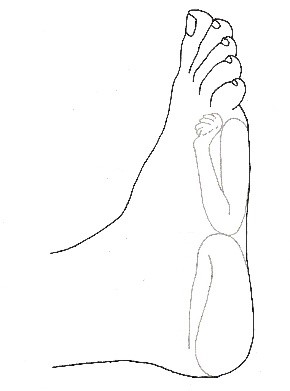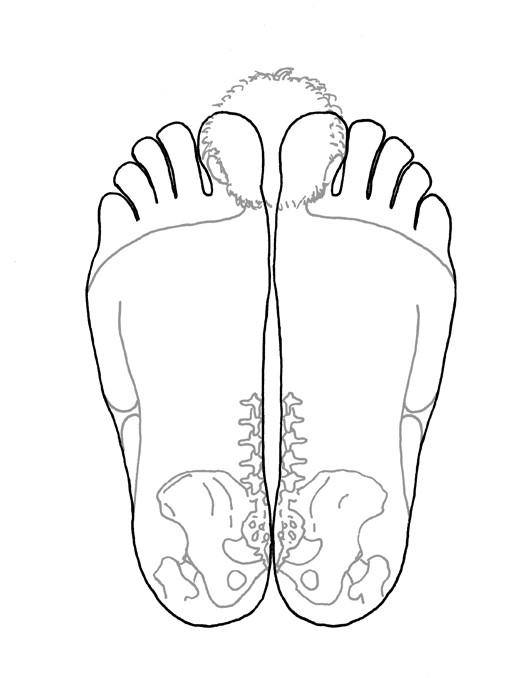Moving Forward to the 21st Century: Combining TCM Theory & Reflexology
An article written by Chin Chu
March 9th, 2015
For over 20 years, I have been learning, practicing, and teaching reflexology. When I look back over the years, I can now see the different phases in my learning curve. Little did I know that 6 years ago, my own understanding of the yin and yang distribution within the body would become the starting point of a new phase, coupled with a deeper appreciation of additional healing methods and modalities. As I reflect on what I have learned, I would like to share some of my own ideas. I believe that many different healing modalities are derived from the same principles. When one utilizes a healing method to its full potential, the end result becomes an amalgamation of all healing modalities. I also believe that all of the pain we experience, new or old, are due to the same root case. This makes it possible to find a procedure to relieve numerous symptoms together, not just one by one. For example, let’s consider tennis elbow and back pain. These two types of pain stem from the same root cause. The theory of yin and yang denotes the balance of nature and opposites. In this case, for every ‘sender’ (yang), there is a ‘receiver’ (yin). If we consider the elbow pain to be yang and the back pain to be yin, then both conditions can be relieved if we balance the two energies together. There are 5 aspects of TCM theory that couple well with reflexology:
- Holographic Image Theory
- Yin and Yang Theory
- Meridian Theory
- Five Element Theory
- Organ Theory
1) Holographic Image Theory
Holographic Image Theory shows the body being represented in other areas of the body. These illustrations reveal how the image of the body is reflected, or projected, in the foot. For instance, the toes are reflexes for the head, and can be used to treat troubles in that region, including headaches, sinusitis, vision, etc. The basic principles of foot reflexology is heavily based on this theory. However, with experience, we learn that not only can the right small toe treat the right side of the head and right shoulder, but it can also treat the left shoulder. And the ankle can treat the hip area, as well as the shoulder too. How is this possible? This can be explained by the Yin and Yang Theory and Five Element Theory.


2) Yin and Yang Theory
Yin and yang theory is the theory of balance in everything we do, all of the things that surround us, and everything that we are. The body has both yin and yang, and every side has an opposite. For instance, in my yin and yang reflexology, the;
- Right shoulder reflects the left shoulder (Right/Left)
- Right shoulder reflects the right hip (Up/Down)
- Right shoulder reflects the left hip (Both Right/Left and Up/Down)
3) Meridan Theory
There are 12 meridians on each side of the body. Energy flows through these channels to keep the body alive and healthy. We already know, based on the Holographic Image Theory, that the ankle reflex treats the hip. The following image depicts the pathway of the gall bladder meridian, indicating its pathway along the hip, leg, and ankle area. This further reasons why the ankle can be used to treat the hip. Firstly, the course of the gall bladder pathway runs through both the hip and ankle area, and secondly, both areas are at the yin and yang position of the leg (upper and lower). The same reasoning can be used to explain the wrist and shoulder reflexes. Both areas are pathways for the lung meridian, and are also at the yin and yang position of the arm. Although these reflexes are able to treat each other, sometimes there is a more effective method of treatment, as described in the Five Element Theory.

4) Five Element Theory
While there is only one energy flowing in a meridian, its quality changes according to the organ that that meridian represents. There are 5 different types of energy in the body; Wood, Fire, Earth, Metal, and Water. The interactions among these types of energies (the 5 elements), help to keep the body in balance. Some enhance each other, while others control or suppress each other. For example:
- Metal enhances Water
- Water enhances Wood
- Wood enhances Fire
- Water suppresses Fire
- Fire suppresses Metal
Continuing my example from above, the meridians in the arm are of Fire and Metal. Pain in the shoulder area is often caused by the imbalance of these two energies. Any treatment used to balance the two elements will relieve the arm and shoulder pain. And in this case, the small toe (since it is a water element) would be a good choice to treat the pain, to suppress the fire and metal.
5) Organ Theory
In TCM, organ functions differ from western medicine due to the flow of energy involved. Every organ controls different functions and parts of the body. For example, in TCM, the liver controls the tendons and nerves, and also promotes the spleen (which in itself controls the muscles). For this reason, many types of pain can be eased to some degree by strengthening or reducing the liver energy.
These simple cases of shoulder, back, and hip pain clearly illustrate the importance of TCM theory in our reflexology methods. With proper training, you will be able to build a unique practice of your own. My yin and yang reflexology is a primary example of that. This is why, after all of these years, I still feel like a young kid in a candy store; full of curiosity, willingness to try new things, and excited for everyday!